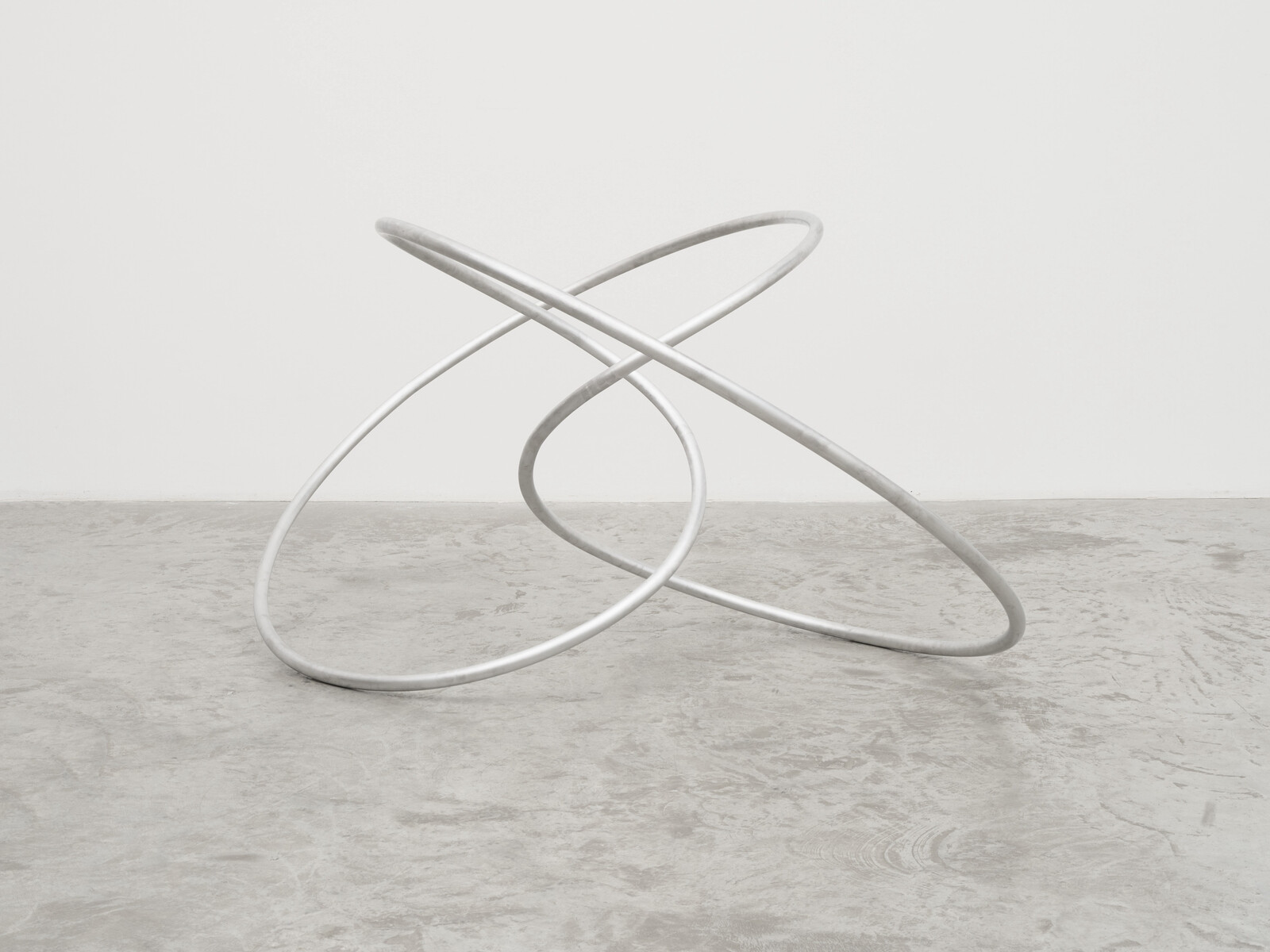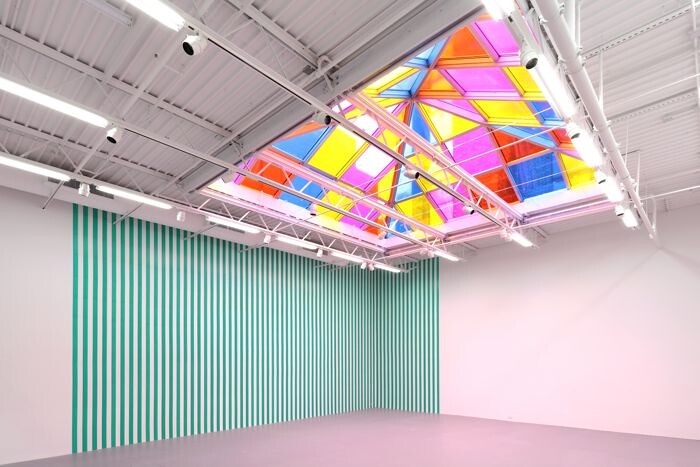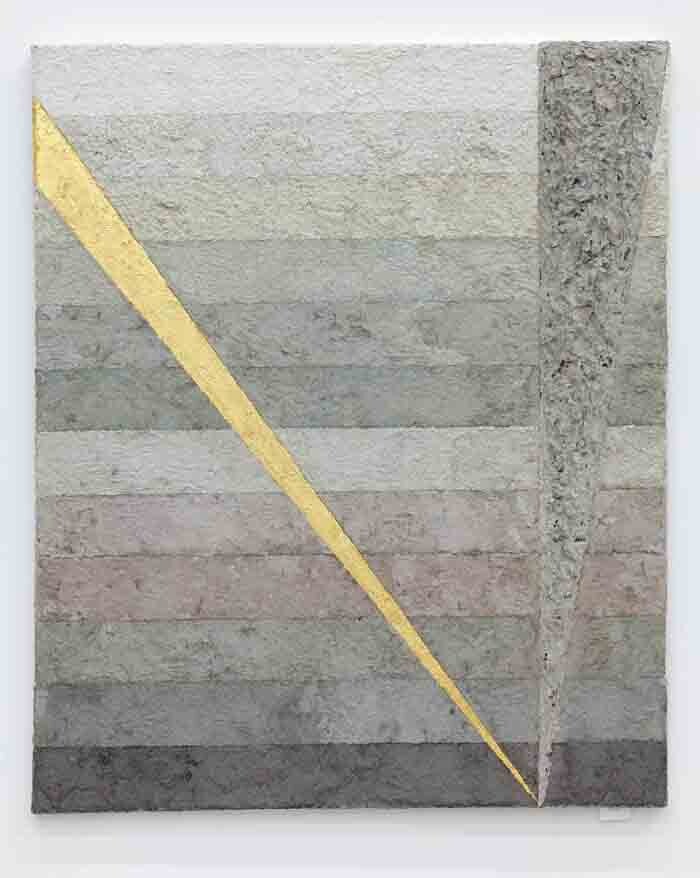Categories
Subjects
Authors
Artists
Venues
Locations
Calendar
Filter
Done
February 27, 2024 – Review
Madeline Hollander’s “Entanglement”
Maddie Hampton

In profile, the six rounded disks at the center of Madeline Hollander’s latest exhibition appear glamorously extraterrestrial, the bright bulbs of the track lighting glinting in their polished chrome surfaces. Arranged in a grid on curved, white pedestals, the satellite-shaped objects are constructed from parabolic mirrors, a hole cut at the top of each to reveal a sinewy figure cast in aluminum, revolving atop a bifurcated circle of colored glass. Based on Hollander’s personalized notation system, specific silhouettes and colors correspond to a precise movement so that, taken in concert, the six figures play out an entire choreography, spinning perpetually in place.
Viewed at the right angle, the maquette doubles, ascending out of the mirror like a ballerina from a jewelry box to create the illusion of a perfect pas de deux—not a limb out of place, nor a posture skipped, as both “dancers” rotate in flawless synchronicity. Titled Entanglement Choreography I-VI (all works 2023), the objects are designed as miniaturized visualizations of quantum entanglement, the theory that two particles can be interdependent, mimicking one another across both space and time, the action of one entirely conditional on that of its partner. Quick and loose with her interpretations of the …
January 25, 2013 – Review
Daniel Buren’s “Electricity Paper Vinyl…” and “Electricity Fabric Paint Paper Vinyl…” Works In Situ and Situated Works from 1968 to 2013 (Dedicated to Michael Asher)
Karen Archey

For nearly five decades, Daniel Buren has used 8.7-centimeter stripes to highlight the lack of phenomenological neutrality of the exhibition space, his ubiquitous colored bands appearing everywhere from institutions such as Paris’s Grand Palais and the Centre Georges Pompidou to the hallowed escalators of Art Basel. Not soon forgotten is his participation and removal from the “Sixth Guggenheim International Exhibition” (1971) at the behest of fellow artists Dan Flavin, Donald Judd, Joseph Kosuth, and Richard Long, who felt their respective installations were aesthetically interrupted by Buren’s striped banner suspended from the institution’s famed rotunda. Buren’s “in situ” work, as well as the Guggenheim incident (which now occupies a chapter in many an art history textbook), taught us that viewing art in an institution is always negotiated by economic and ideological factors, and that aesthetic autonomy is merely a delusion. In an early example of institutional critique, Buren’s stripes point outward toward the institution, prompting us to reflect upon both the architecture and function of the museum itself.
But what happens when institutional critique is taken out of the institution and located in a commercial gallery? Does it become an empty, decorative gesture? Buren’s first solo exhibition in New York since …
April 7, 2011 – Review
Anna Ostoya’s "Exposures" at Bortolami Gallery, New York
Merve Ünsal

Anna Ostoya’s twenty-eight canvases in Bortolami Gallery mark the twenty-eight days of February 2011. Upon the gallery’s invitation, Ostoya set herself specific rules of production—to initiate a new piece each day for the duration of February, and to work only on 20 x 24 inch canvases with four main materials: newspaper, gold leaf, acrylic paint and papier-mâché. The resulting series of 28 works, Exposures on display are thus residues of a performative, diaristic process that the artist obscures with formal finesse.
Each canvas is remarkably different. While a black and white eye that would make Deren proud marks one canvas, another is void of any images, a bare monochromatic papier-mâché relief. In another piece, an upside-down L of images interwoven with yellow stripes, contrasts a Mondrian-like grid. While one diagonal is a dash of color, another is a collage of images of hands. The canvases are installed at equal distances apart, in a single line around the larger rectangular room of the gallery’s two spaces, triggering a staccato yet rarely surprising experience.
Ostoya’s On Kawara-esque pre-determination of the process is not a means of trammeling; on the contrary, having to use what exists in the newspapers on the day of, to trigger …
